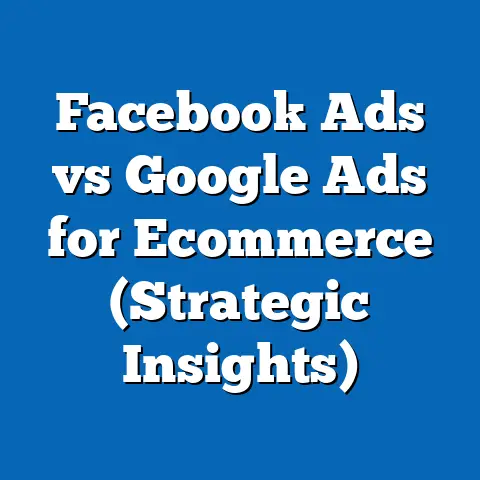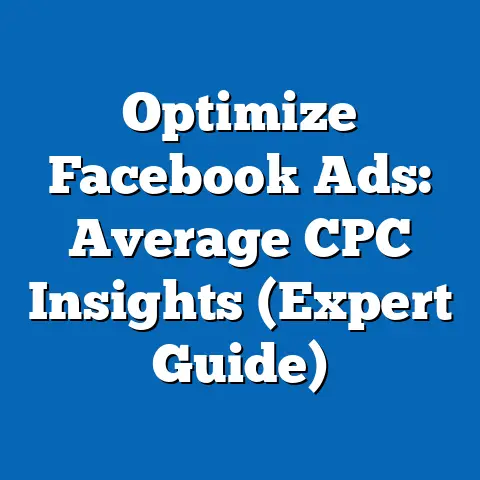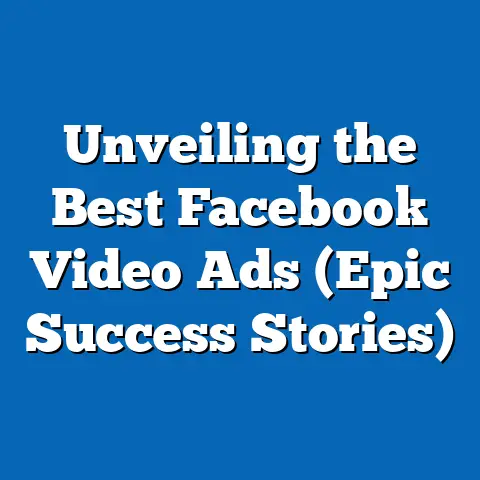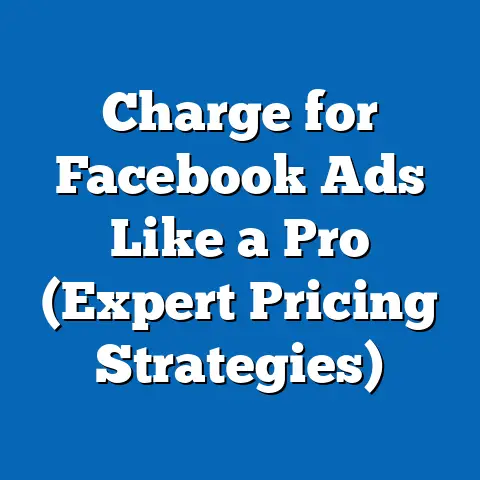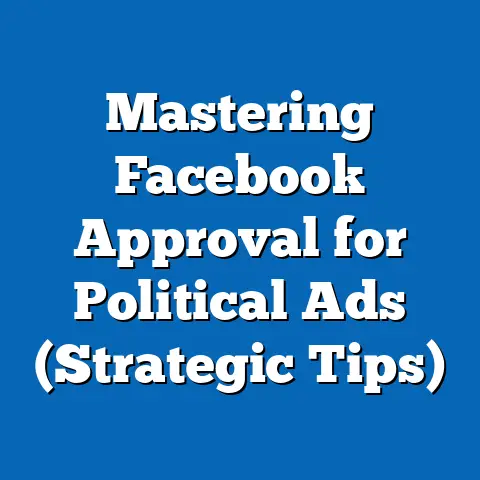Boost Clicks with Effective Facebook Link Ads (Pro Tips)
In today’s digital world, where everyone is shouting for attention, it’s tough to make your voice heard. As a marketer, I know the frustration of crafting what I believe is a brilliant Facebook ad, only to watch it disappear into the abyss of countless other posts. The challenge is real: how do you cut through the noise and get people to actually click on your ads?
Many businesses struggle with this, pouring money into Facebook ads only to see lackluster results. Low click-through rates (CTR) can be disheartening, leading to wasted budgets and missed opportunities to connect with potential customers. I’ve been there myself, staring at disappointing metrics and wondering where I went wrong.
But here’s the good news: effective Facebook Link Ads can be a game-changer. When done right, they can significantly boost engagement and drive valuable traffic to your website or landing pages. The key is understanding the nuances of crafting ads that not only grab attention but also compel users to take action.
In this article, I’m going to share some pro tips that I’ve learned over the years, strategies that have helped me turn underperforming ads into click-generating machines. We’ll dive deep into the key components of a successful Link Ad, from eye-catching visuals and compelling copy to precise targeting and smart budgeting. By the end of this guide, you’ll have the knowledge and tools you need to create Facebook Link Ads that not only get noticed but also drive real results for your business.
Understanding Facebook Link Ads
So, what exactly are Facebook Link Ads? Simply put, they’re a type of Facebook ad designed to drive traffic from Facebook to a specific URL, usually a landing page or website. Think of them as a digital billboard, strategically placed within the Facebook ecosystem to entice users to click and explore what you have to offer.
These ads typically consist of an image or video, a headline, a description, and a call-to-action button. When a user clicks on the ad, they’re taken directly to the URL you’ve specified. This makes Link Ads incredibly effective for:
- Driving traffic to your website: Whether you’re promoting a new product, sharing valuable content, or simply want to increase brand awareness, Link Ads can help you get more eyes on your website.
- Generating leads: By directing users to a landing page with a lead capture form, you can collect valuable contact information and build your email list.
- Increasing sales: If you have an e-commerce store, Link Ads can be used to showcase your products and drive sales directly from Facebook.
But why choose Link Ads over other ad formats, like video ads or lead generation ads? Here’s what I’ve learned:
- Direct control over the user experience: With Link Ads, you have complete control over the landing page or website the user is directed to. This allows you to create a seamless and optimized experience, tailored to your specific goals.
- Cost-effective: In many cases, Link Ads can be more cost-effective than other ad formats, especially when you’re focused on driving traffic.
- Versatile: Link Ads can be used for a wide range of purposes, from promoting blog posts to selling products.
Real-World Example:
I once worked with a local bakery that wanted to increase online orders. We created a Facebook Link Ad featuring mouthwatering photos of their cakes and pastries, with a headline that read “Order Your Custom Cake Today!” and a call-to-action button that said “Shop Now.” By targeting users in the bakery’s local area who had shown an interest in baking and desserts, we were able to drive a significant increase in online orders, resulting in a 30% boost in revenue within the first month.
Takeaway: Facebook Link Ads are a powerful tool for driving traffic, generating leads, and increasing sales. Their versatility and cost-effectiveness make them a valuable addition to any marketer’s toolkit.
Crafting the Perfect Ad: Key Components
Creating a successful Facebook Link Ad is like baking a perfect cake – you need the right ingredients and the right recipe. Here’s a breakdown of the key components:
Visuals: The Eye-Catching Hook
In a world of endless scrolling, your ad’s visual is your first and often only chance to grab someone’s attention. Think of it as the movie poster that makes you want to see the film. Here’s what I’ve learned about creating visuals that stop the scroll:
- High-quality images or videos are a must: Blurry, pixelated images scream unprofessionalism. Invest in high-resolution visuals that are clear, crisp, and visually appealing.
- Ideal dimensions: Facebook’s ad specs can be a moving target, so always check the latest guidelines. As of today, for single image or video ads in the feed, I recommend using an aspect ratio of 1.91:1 (landscape) or 1:1 (square). For stories, use 9:16 (full portrait).
- Relevance is key: Your visual should be directly relevant to your product, service, or offer. Don’t use generic stock photos that don’t resonate with your target audience.
- Showcase your product in action: If you’re selling a physical product, show it being used in a real-life scenario. This helps potential customers visualize themselves using the product and understand its benefits.
- Use video to tell a story: Video ads are incredibly engaging, especially on mobile. Create short, attention-grabbing videos that showcase your brand’s personality and value proposition.
My Experience:
I once ran two identical ads for a fitness app, the only difference being the visual. One ad used a generic stock photo of someone working out, while the other featured a video of a real user sharing their success story with the app. The video ad outperformed the stock photo ad by a whopping 200% in terms of CTR. This taught me the power of authentic, relatable visuals.
Ad Copy: Words That Convert
Your ad copy is where you seal the deal. It’s your opportunity to explain why someone should click on your ad and visit your website. Here are my tips for writing compelling ad copy:
- Headline: This is the first thing people will see, so make it count. Keep it short, punchy, and attention-grabbing. Use strong verbs and create a sense of urgency. Examples: “Limited Time Offer,” “Don’t Miss Out,” “Get Yours Now.”
- Description: This provides more context and detail about your offer. Highlight the key benefits and address any potential objections. Use persuasive language and create a sense of FOMO (fear of missing out).
- Value proposition: Clearly communicate the value you’re offering. What problem does your product or service solve? How will it improve the user’s life?
- Call out your target audience: Use language that resonates with your target audience. For example, if you’re targeting millennials, use slang and references that they’ll understand.
- Keep it concise: People have short attention spans, so get to the point quickly. Use short sentences and paragraphs, and avoid jargon.
Example:
Let’s say you’re selling a course on social media marketing. Here’s an example of effective ad copy:
- Headline: Master Social Media Marketing in 30 Days!
- Description: Learn the secrets to growing your business with social media. Our comprehensive course covers everything from content creation to ad campaigns. Limited spots available!
- Call to Action: Sign Up Now!
Call to Action (CTA): Tell Them What to Do
Your call to action is the final nudge that encourages users to click on your ad. It’s the instruction that tells them what you want them to do next. Here’s how to create a strong CTA:
- Use clear and concise language: Tell users exactly what you want them to do. Examples: “Shop Now,” “Learn More,” “Sign Up,” “Download Now.”
- Create a sense of urgency: Encourage users to take action immediately. Examples: “Limited Time Offer,” “Sale Ends Soon,” “Claim Your Discount.”
- Make it visually appealing: Use a button with a contrasting color that stands out from the rest of the ad.
- Test different CTAs: Experiment with different CTAs to see which ones perform best.
Takeaway: Crafting the perfect Facebook Link Ad is a combination of art and science. By using high-quality visuals, compelling ad copy, and a strong call to action, you can create ads that not only grab attention but also drive real results.
Targeting Your Audience Effectively
You could have the most visually stunning ad with the most persuasive copy ever written, but if you’re showing it to the wrong people, it’s like shouting into the void. Effective targeting is crucial to ensuring your ads reach the right audience and generate the desired results.
Facebook offers a wealth of targeting options, allowing you to reach specific groups of people based on their demographics, interests, behaviors, and more. Here’s a breakdown of the key targeting options:
- Demographics: Target users based on age, gender, location, education, relationship status, and more.
- Interests: Target users based on their interests, hobbies, and passions. Facebook gathers this information from the pages they like, the groups they join, and the content they interact with.
- Behaviors: Target users based on their online and offline behaviors, such as purchase history, travel habits, and device usage.
- Custom Audiences: This allows you to target users who have already interacted with your business, such as website visitors, email subscribers, or customers.
- Lookalike Audiences: This allows you to create audiences that are similar to your existing customers or website visitors.
The Importance of Audience Segmentation:
One of the biggest mistakes I see marketers make is targeting everyone with the same ad. This is like using a shotgun when you need a sniper rifle. Audience segmentation involves dividing your target audience into smaller, more specific groups based on their characteristics and needs. This allows you to tailor your ads to each segment, increasing their relevance and effectiveness.
Example:
Let’s say you’re selling a line of organic skincare products. You could segment your audience based on:
- Age: Target younger users with ads that focus on acne prevention, and older users with ads that focus on anti-aging.
- Location: Target users in urban areas with ads that focus on pollution protection, and users in rural areas with ads that focus on sun protection.
- Interests: Target users who are interested in organic skincare, natural beauty, and sustainable living.
Using Facebook Pixel and Custom Audiences for Retargeting:
The Facebook Pixel is a small piece of code that you install on your website. It allows you to track the actions that users take on your website, such as visiting specific pages, adding items to their cart, or making a purchase. This information can then be used to create Custom Audiences and retarget users who have shown interest in your products or services.
My Strategy:
I always create a Custom Audience of website visitors who have visited my product pages but haven’t made a purchase. I then retarget these users with ads that offer a discount or free shipping, encouraging them to complete their purchase. This strategy has significantly increased my conversion rates.
Takeaway: Effective targeting is essential for maximizing the ROI of your Facebook Link Ads. By segmenting your audience, using Facebook Pixel, and retargeting users who have shown interest, you can ensure that your ads reach the right people and generate the desired results.
Optimizing Ad Placement and Budget
Now that you’ve crafted the perfect ad and identified your target audience, it’s time to think about where your ad will be shown and how much you’re willing to spend. Optimizing ad placement and budget is crucial for maximizing the reach and effectiveness of your Facebook Link Ads.
Understanding Ad Placements:
Facebook offers a variety of ad placements, each with its own unique characteristics and advantages. Here are some of the most common placements:
- Facebook News Feed: This is the most popular placement, as it’s where most users spend their time. Ads in the News Feed are highly visible and can be very effective for driving traffic.
- Facebook Stories: Stories are a full-screen, immersive format that’s popular with younger audiences. Ads in Stories can be very engaging, but they need to be visually appealing and attention-grabbing.
- Facebook Marketplace: This is a great placement for promoting products, especially if you’re targeting users who are actively looking to buy something.
- Facebook Right Column: This placement is less visible than the News Feed, but it can still be effective for driving traffic, especially if you’re targeting users on desktop computers.
- Instagram Feed: If your target audience is active on Instagram, this is a great placement for reaching them.
- Instagram Stories: Similar to Facebook Stories, this is a full-screen, immersive format that’s popular with younger audiences.
- Audience Network: This allows you to show your ads on other websites and apps that are part of Facebook’s Audience Network.
Choosing the Best Placements for Link Ads:
For Link Ads, I generally recommend focusing on the Facebook News Feed and Instagram Feed. These placements offer the best visibility and engagement, and they’re well-suited for driving traffic to your website. However, it’s important to test different placements to see what works best for your specific audience.
Budgeting Strategies:
Facebook offers two main budgeting options:
- Daily Budget: This allows you to set a fixed amount that you’re willing to spend each day.
- Lifetime Budget: This allows you to set a total amount that you’re willing to spend over the entire duration of your campaign.
My Recommendation:
For most campaigns, I recommend using a daily budget. This gives you more control over your spending and allows you to make adjustments as needed.
Setting Bids for Optimal Performance:
Facebook uses an auction system to determine which ads are shown to users. When you create an ad, you’re essentially bidding against other advertisers for the opportunity to show your ad to your target audience.
You can choose to set your bids manually or let Facebook automatically optimize them for you. I generally recommend letting Facebook automatically optimize your bids, as this can often lead to better performance.
A/B Testing Placements and Budgets:
The best way to optimize your ad placement and budget is to A/B test different options. This involves creating multiple versions of your ad with different placements and budgets, and then tracking their performance to see which ones generate the best results.
Takeaway: Optimizing ad placement and budget is crucial for maximizing the reach and effectiveness of your Facebook Link Ads. By understanding the different ad placements, budgeting strategies, and bidding options, you can ensure that your ads are shown to the right people at the right time, without breaking the bank.
Analyzing Performance: Metrics That Matter
You’ve launched your Facebook Link Ads, and now it’s time to see how they’re performing. Tracking the right metrics is essential for understanding what’s working, what’s not, and how you can improve your campaigns over time.
Here are some of the key performance indicators (KPIs) that I track for Link Ads:
- Click-Through Rate (CTR): This is the percentage of people who see your ad and click on it. A high CTR indicates that your ad is relevant and engaging.
- Cost Per Click (CPC): This is the amount you pay each time someone clicks on your ad. A low CPC indicates that your ad is cost-effective.
- Conversion Rate: This is the percentage of people who click on your ad and then take a desired action on your website, such as making a purchase or filling out a form.
- Return on Ad Spend (ROAS): This is the amount of revenue you generate for every dollar you spend on ads. A high ROAS indicates that your ad campaign is profitable.
Using Facebook Ads Manager to Monitor Metrics:
Facebook Ads Manager provides a wealth of data and insights about your ad campaigns. You can use it to monitor your KPIs, track your spending, and identify areas for improvement.
Interpreting Data to Make Informed Decisions:
The key to successful Facebook advertising is to continuously analyze your data and make informed decisions based on your findings. For example, if you notice that your CTR is low, you might want to try changing your ad copy or visual. If you notice that your CPC is high, you might want to try targeting a different audience.
Real-World Example:
I once ran a Facebook Link Ad campaign for a client that was generating a high CTR but a low conversion rate. After analyzing the data, I realized that the landing page was not optimized for conversions. I made some changes to the landing page, such as adding a clear call to action and simplifying the checkout process, and the conversion rate skyrocketed.
Takeaway: Analyzing your performance metrics is essential for optimizing your Facebook Link Ads and maximizing your ROI. By tracking the right KPIs, using Facebook Ads Manager, and interpreting your data, you can make informed decisions that will improve your campaigns over time.
Pro Tips for Continuous Improvement
Facebook advertising is not a “set it and forget it” kind of thing. It’s a continuous process of testing, learning, and optimizing. Here are some pro tips for refining and improving your Facebook Link Ads over time:
- Stay Up-to-Date with Facebook’s Algorithms: Facebook’s algorithms are constantly changing, so it’s important to stay informed about the latest updates and best practices. Follow industry blogs, attend webinars, and join Facebook advertising groups to stay in the know.
- Keep an Eye on Industry Trends: Pay attention to what’s working in your industry and adapt your strategies accordingly. What are your competitors doing? What types of ads are generating the most engagement?
- Learn from Competitor Strategies: Don’t be afraid to analyze your competitors’ Facebook ads. What types of visuals are they using? What kind of copy are they writing? What audiences are they targeting? You can learn a lot from their successes and failures.
- Gather Audience Feedback: Ask your customers for feedback on your ads and landing pages. What do they like? What do they dislike? What could you do to improve their experience?
- Incorporate Feedback into Future Campaigns: Use the feedback you gather to improve your future campaigns. This will help you create ads that are more relevant, engaging, and effective.
My Personal Strategy:
I set aside time each week to review my Facebook ad campaigns and look for areas for improvement. I also regularly test new ad creatives, targeting options, and bidding strategies. This continuous improvement process has helped me consistently achieve better results over time.
Takeaway: Continuous improvement is essential for long-term success with Facebook advertising. By staying up-to-date, learning from others, gathering feedback, and incorporating it into your future campaigns, you can ensure that your ads are always performing at their best.
Conclusion
We’ve covered a lot of ground in this article, from understanding the basics of Facebook Link Ads to implementing advanced optimization strategies. I hope you’ve found these pro tips helpful and that you’re feeling confident about creating your own high-performing Link Ads.
Remember, the key to success with Facebook advertising is to be persistent, patient, and willing to experiment. Don’t be afraid to try new things, test different approaches, and learn from your mistakes.
Effective Facebook Link Ads can be a powerful tool for driving traffic, generating leads, and increasing sales. By implementing the strategies discussed in this article, you can significantly boost your click-through rates and achieve your business goals.
So, what are you waiting for? Take action today and start testing these pro tips in your next Facebook ad campaign. I’m confident that you’ll see a positive impact on your results. Good luck!

